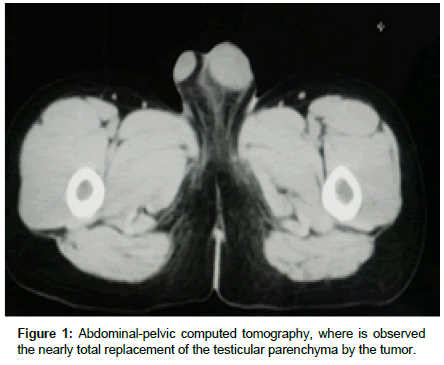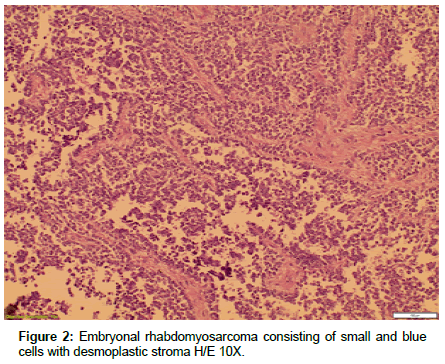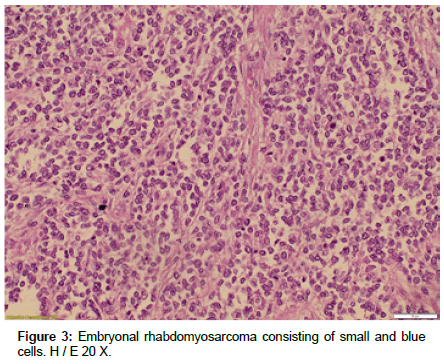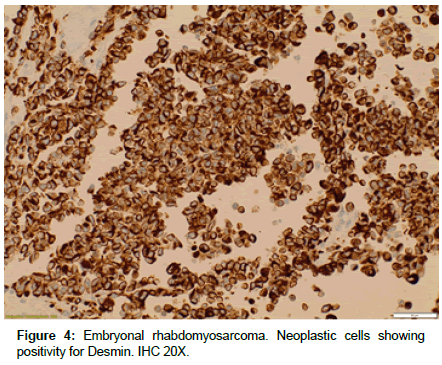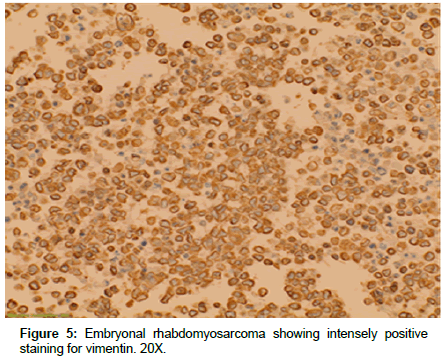Case Report, Clin Oncol Case Rep Vol: 1 Issue: 1
Rare Testicular Tumor Report of a Case
Sirced Salazar Rodríguez, Ángel Vinces, Severino Rey*, Julio Guillem Cedeños, Onay Solis and Hugo Boccara
Pathological Anatomy Society to Fight Cancer, FORESC/FEBIP, USA
*Corresponding Author : Severino Rey
President FORESC/FEBIP, USA
E-mail: sevrey@yahoo.es
Received: December 26, 2017 Accepted: March 16, 2018 Published: March 23, 2018
Citation: Rodríguez SS, Vinces A, Rey S, Cedeños JG, Solis O, et al. (2018) Rare Testicular Tumor Report of a Case. Clin Oncol Case Rep 1:1.
Abstract
Background: Mesenchymal neoplasms of the male genital tract are rare, and most are located Para testicular and testicular adnexal. The sarcomas, the most frequent in the child with this location are the Para testicular embryonal rhabdomyosarcoma (RMS). Case report: Male 4 years old, without personal pathological history, complained of pain and increased left testicular volume of 2 months evolution. Upon physical examination, the left scrotal sac was enlarged, without change in coloration, indurated, not very painful. The right testicle showed no alterations. Conclusion: The RMS is the most frequent soft tissue tumor in childhood and the genitourinary location is the second most frequent after the head and neck region. Primary intratesticular rhabdomyosarcoma is uncommon.
Keywords: Intratesticular; Embryonal rabdomyosarcoma
Introduction
Testicular tumors are divided into 5 general categories, being the most frequent those originated from germ cells (90%); stromal tumors of the sex cord; mixed tumors of the sex cord stroma and germ cells; primary tumors not specific to the testicle; and metastatic tumors [1].
Mesenchymal neoplasms of the male genital tract are rare, and most are located in structures for testicular and testicular adnexa, within the sarcomas; the most frequent in the child with this location is the paratesticular embryonal rhabdomyosarcoma (RMS) [1].
Rhabdomyosarcomas are the most common soft tissue sarcomas in children under 15 years. It is estimated that they represent approximately 8% of malignant childhood tumors, with an incidence of 4.5 cases per million children and adolescents [1,2]. The RMS is more frequent in the head and neck, followed by the genitourinary region [3]. Within the genitourinary region, the ones located in the bladder and Para testicular are the most frequent [4].
The intratesticular RMS is uncommon and is barely reported in the literature [4-9]. The origin of a primary intratesticular sarcoma is derived from two fundamental theories, by the malignant transformation of a germinal neoplasm of type teratoma, or due to a process of dedifferentiation of multipotential germ cells [5].
In a study conducted by the cancer registries of the Society to Fight Cancer (centers Quito, Cuenca, Loja, and Manabi), showed that the most frequent age of childhood tumors was 1-4 years old, being the most frequent neoplasms, leukemias, lymphomas, and the central nervous system. The sarcomas were in 9th place with 5.1% of the total registered cases [9].
Intratesticular sarcomas that are not associated with germ cell tumors or retroperitoneal metastases are a unique type of intrascrotal sarcoma 3. Prince in 1942 reported that 1 to 2% of testicular tumors are sarcomatous, and only a small percentage of these are rhabdomyosarcomas, with an age of presentation that varies from 21 months to 67 years old [6,7].
Case Report
A male 4 years old, no significant past history, complained of pain and increased left testicular volume of two months evolution. Upon physical examination, the left scrotal sac was enlarged, without change in coloration, indurated, not very painful. The right testicle showed no alterations. The laboratory tests were found within normal parameters, except for the lactate dehydrogenase (LDH) that was high (210UI/L).
The testicular ultrasound showed an interface line at the level of the left testicle, with a well-defined round heterogeneous mass with hyper echoic points inside it, with increased vascularization compared to the rare residual testicular parenchyma. The abdominopelvic computed tomography showed a marked increase of the left testicle, almost completely replaced by tumor mass (Figure 1).
The left radical orchiectomy was performed. The surgical piece measured 6.0 x 2.3 x 1.5 cm. The gross appearance showed that the testicle was replaced by an oval formation of 5 x 2 x 1.5 cm; yellowishwhite color with cystic degeneration in the upper pole, which covered more than 95% of the testicular parenchyma, no necrosis was identified. The spermatic cord was free of lesion.
In the histological study, we found a poorly differentiated, hyper cellular neoplasm, of round blue, small and medium cells, with abundant mitosis. The tumor is formed almost exclusively by primitive cells without rhabdomyoblastic differentiation (Figures 2 and 3).
The immunohistochemistry showed positivity for Vimentin and Desmin being negative for the rest of the markers, including the specific muscle alpha-actin (Figures 4 and 5).
Diagnosing as embryonic rhabdomyosarcoma of small cells with alveolar pattern, intratesticular with infiltration of epididymis, invasion of tunica albuginea, and tunica vaginalis, with several foci of vascular invasion. No invasion to the testicular hilum, without infiltration to the spermatic duct. No per neural invasion. The margins of the tunica vaginalis were compromised.
The patient after radical surgery, once the diagnosis was confirmed, and the extension study was completed; the adjuvant treatment was performed following the current SIOP protocol in our center at the time of diagnosis. It is currently in the 7th VAT cycle (Ifosfamida, Vincristine and Actinomycin D) with complete remission of its disease. The patient did not have metastases.
Discussion
Testicular tumors represent between 1 to 2% of malignant solid tumors1. The majority of these tumors (75 to 80%) are germinal origin 10. Rhabdomyosarcomas (RMS) are the most common soft tissue tumors in and adolescents, representing 2 to 3% of childhood tumors. Its annual incidence is 4.3 cases per million [10].
The majority of RMS is present in children under 6 years old, and is located anywhere in the body, being the genitourinary location, the second most frequent after the head and neck [4]. In the genitourinary region, the most frequent site corresponds to the bladder, followed by the paratesticular; the intratesticular location is very rare [6,11,12].
The clinical presentation is very variable, and the diagnosis of certainty is established by biopsy with histopathological study, requiring in a high percentage of cases the immunohistochemistry for the typing of the tumor cells.
The patient reported in this article presented elevation of the LDH; it is elevated in tumor and non-tumor pathological states it has been reported in cases of rhabdomyosarcomas by other authors [12].
Histologically, according to the international classification of rhabdomyosarcoma (CIR) for child age, divide the RMS, in those with better prognosis (Botrytis RMS and Spindle cells RMS) (both variants of the embryo), intermediate grade (Conventional embryonal RMS) and high grade (Alveolar RMS, Undifferentiated RMS). The Pleomorphic RMS is excluded from this classification due to its extraordinary rarity in children. An aplasia is a characteristic that is seen more frequently in embryos [3,11].
Pure embryonal RMS account for about 49% of all RMS, affecting mostly children under 10 years old, although, they also occur in adolescents and young adults with much less frequency, being rare in adult patients [3]. The most common histologic type is embryonic, as in our case [4].
Primary testicular mesenchymal tumors may originate within testicular teratomas or from interstitial testicular stromal cells or multipotential primitive cells with a capacity of multiple differentiations. In our case, there was no evidence of association with testicular teratoma, which is why we conclude it as a primary sarcoma of intraparenchymal location.
Among the sarcomas that has been registered as primary testicular they have been reported, osteosarcomas, leiomyosarcomas, Kaposi’s sarcoma, rhabdomyosarcoma [4,6,7,13-19].
The clinical stage of these tumors is very variable and depends on the location, age of the patient and stage at diagnosis, with or without the presence of distant metastases. A reasonable number of these tumors in early stages are asymptomatic, so in most cases they are diagnosed in advanced stages. The survival rate of patients with these tumors has undergone a significant increase in the last decades, going from a 5-year disease free survival from 66% to 74% in the last 20 years [13].
The diagnosis of these sarcomas is based on histopathological and immunohistochemical studies. In the histological study we can see a diverse morphology, from RMS with poorly differentiated pattern difficult to diagnose without IHC study, and other well differentiated that resemble the fetal muscle [3,4,11]. The patient reported in this study presented a poorly differentiated pattern in its totality, which required IHC studies for the conclusive diagnosis.
From the microscopic point of view, we can observe variable degrees of cellularity, with hyper cellular areas that alternate with myxoid areas, From the microscopic point of view we can observe variable degrees of cellularity, with hyper cellular areas alternating with myxoid areas, presence of different types of cells with variable proportion from one tumor to another; undifferentiated round cells, spindle cells and rhabdomyoblasts. The stroma is usually collagen with variable amounts of myxoid material and in a percentage of cases transverse striations are observed in the cytoplasm of the tumor cells [3,20].
The microscopic aspect of the reported case corresponds to a poorly differentiated tumor, formed mostly by small, round cells with hyper chromatic nuclei, poorly defined cytoplasm, little variation in cell size, abundant mitosis, without the presence of rhabdomyoblasts, or fusocellular component.
Several immunohistochemical stains were performed for the differential diagnosis of small and blue cell tumors; as well as studies of germ cell tumor markers, to rule out its origin (Table 1).
| Marker | Results |
|---|---|
| Vimentin | Positive |
| Desmin | Positive |
| Enolase | Negative |
| S100 Protein | Negative |
| CD99 | Negative |
| LCA | Negative |
| Muscle-Specific Actin | Negative |
| Alpha-fetoprotein | Negative |
| PLAP | Negative |
| HCG | Negative |
Table 1: Result of Immunohistochemistry.
The case presented positive immunoreactivity for vimentin and desmin, being negative for the rest of the markers, including the muscle specific alpha-actin. Many markers are applied to the diagnosis of RMS, but its usefulness, sensitivity and specificity vary. Among the most used we find the desmin that marks the intermediate filaments of the muscle, it is positive in more than 90% of the RMS although it can be positive in 50 to 70% of the leiomyosarcomas. Its positivity has been reported for some small round and blue cell tumors as is the case of Ewing’s Sarcoma/Primitive Neuroectodermal tumor [3,21,22].
Although, myoglobin is a specific marker for skeletal muscle tumors, it is not very sensitive [3]. The positivity of this marker is manifested more in better differentiated cells.
Immunostaining with my regulatory proteins such as MyoD1 have a high sensitivity and specificity [3,13,19,23]. Although, the expression of MyoD1 is higher in the Alveolar RMS than in the embryonic ones. Although the expression of MyoD1 is higher in the alveolar RMS than in the embryonal. This marker has high utility for the differential diagnosis of small and blue cell tumors, RMS and between pleomorphic RMS, and other pleomorphic sarcomas.In our case the diagnosis was based on the morphology of a tumor of round, small and blue cells, so a mobile directed for this purpose was indicated and to rule out the association with germ cell tumors of the testicle. The immunophenotype of the case studied showed positivity only for vimentin and Desmin, with a null expression for lymphoid, neuroectodermal, smooth muscle, epithelial, and germ cell markers (Table 1). The placental alkaline phosphatase (PLAP) that marks germ cell tumors have been positive in some rhabdomyosarcoma, especially alveolar type [3,4,23]. In our case it was negative for this marker.
The alveolar RMS is associated with a frequent translocation, t (2; 13) and a less common t (1; 13), which results in a fusion of the PAX3 and PAX7 genes, respectively, with the FKHR (fork head in rhabdomyosarcoma) located at 13q1431. There are no markers of this type for the rest of the RMS [23,24].
Regarding the prognosis of RMS, in the last decades its prognosis has improved, before the 60s the prognosis was very bad, and very low survival at 5 years old. This has been improved with the multidisciplinary management consisting of biopsy or radical surgery according to the location, combined chemotherapy with or without radiotherapy [4].
In our case, once the diagnosis was confirmed and once the extension study was completed, the treatment was carried out following the current SIOP protocol in our center.
Favorable and unfavorable factors are described in rhabdomyosarcomas [3,25]. In our case, favorable factors include age, location, absence of regional and distant metastases, and complete initial resection. Among the unfavorable is the tumor size that was greater than 5 cm.
Mitotic activity has little value in predicting response to treatment and disease progression, as well as studies of ploidy that are not yet conclusive [3]. Recurrence is seen with frequencies in inadequately treated patients.
Conclusions
The RMS is the most frequent soft tissue tumor in childhood and the genitourinary location is the second most frequent after the head and neck region. Primary intratesticular rhabdomyosarcoma is uncommon. The diagnosis is made by histopathological study supported by Immunohistochemistry. With the new treatment strategies, the survival of patients affected with this tumor has improved markedly.
References
- Mostofi FK, Sesterhenn IA (2004) Pathology and Genetics of Tumours of the Urinary System and Male Genital Organs.World Health Organization Classification of Tumours, Tumours of the Testis and Para testicular Tissue. IARCPress, Lyon, France.
- Andrade CR, Takahama A, Nishimoto IN, Kowalski LP, Lopes MA (2010) Rhabdomyosarcoma of the head and neck: aclinicopathological and immunohistochemical analysis of 29 cases. Braz Dent J 21: 68-73.
- Weiss S W, Goldblum J R (2010) Tumors of soft tissues. Rabdomiosarcoma: Elsevier. 595-633.
- Morante Valverde R, Cabezali Barbanco D, Moreno Zegarra C, Gonzalez Herrero M, et al. 2014 Rabdomiosarcoma genitourinario en la infancia, nuestra experiencia. Cir Pediatr 27: 53-56.
- Sumerauer D, Vicha A, Zuntova A, Stejskalova E, et al. (2006) Teratoma in an adolescent with malignant transformation intoembryonal rhabdomyosarcoma. J Pediatr Hematol Oncol 28: 688-692.
- Erkan Erbay M, Tarhan F, Barisik NO, Kuyumcuoğlu U (2003) A case of testicular rhabdomyosarcoma. Int Urol Nephrol 36: 73-75.
- Esther Caliope Carrera Mayor, Francisco Ramos Salgad, Andrés Martínez Cornelio, Isabel Alvarado Cabrero (2010) Rabdomiosarcoma alveolar intratesticular. Revista latinoamericana patologia 48: 250-252.
- Crist W, Gehan EA, Ragab AH, Dickman PS, Donaldson SS, et al. (1995) The third Intergroup Rhabdomyosarcoma Study. J Clin Oncol 13: 603-30.
- Society to fight against cáncer, Solca Quito. Epidemiology of cancer in Quito. Project my child first of all.2014. Quito.
- Ries LAG, Harkins D, Krapcho M, Mariotto A, Miller BA, et al. (2006) SEER Cancer Statistics Review, National Cancer Institute, Bethesda.
- Marco Antonio Rodríguez-Florido, Mercedes Hernández-González, Jesús Aguirre-García, María Guadalupe García-Gomar, Lucero Juárez-Santiago, et al. (2009) Intrascrotal sarcomas. Study of 13 cases. Rev Med Hosp Gen Mex 72: 78-84.
- Caridad Verdecia Cañizares, Magda Alonso Pírez, Andrés Manuel Portugués Díaz. (2011) An unusual case of rabdomiosarcoma. Jour Cuban Pediatr.
- Jun Y. Dong AI, Ji-Ronh H, Yun-Hua (2015) Primary intratesticular rhabdomyosarcoma, A case report and literature review. Oncology letters 11: 1016-1020.
- Smith MA, Seibel NL, Altekruse SF, Ries LA, Melbert DL, et al. (2010) Outcomes for children and adolescents with cancer: challenges for the twenty-first century. J Clin Oncol. 28: 2625-2634.
- Zukerberg LR, Young RH (1990) Primary testicular sarcoma: a report of two cases. Hum Pathol 21: 932-935.
- Washecka RM, Mariani AJ, Zuna RE, Honda SA, Chong CD. (1996) Primary intratesticular sarcoma. Immunohistochemical ultrastructural and DNA flow cytometric study of three cases with a review of the literature. Cancer 77: 1524-1528.
- Davis AE (1962) Rhabdomyosarcoma of the testicle. J Urol 87: 148-154
- Alexander F (1968) Pure testicular rhabdomyosarcoma. Br J Cancer 22: 498-501.
- Kumar PV, Khezri AA (1987) Pure testicular rhabdomyosarcoma Br J Urol 59: 282.
- Raney B, Anderson J, Barr F (2010) Rhabdomyosarcoma and undifferentiated sarcoma: A selectivereview of intergroup rhabdomyosarcoma study group experience and rationale for intergrouprhabdomyosarcoma study V. J Hematol Oncol. 23: 215-20.
- Kummar, V, Abbas A, Aster J (2018) Robbins Basic Patology. (10th Edition), Elsevier.
- Isidro Machado, Samuel Navarro, Antonio Llombart-Bosch (2012) Pautas en el diagnóstico morfológico, inmunohistoquímico y genético de los tumores de células redondas y pequeñas con especial referencia al sarcoma de Ewing/PNET. Revista Española de Patología 45: 145–156.
- Susan C Lester (2010) Manual of surgical pathology. (3rd Edition), Elsevier.
- Barr FG, Galili N, Holick J, Biegel JA, Rovera G, et al. (1993) Rearrangement of the PAX3 paired box gene in the paediatric solid tumour alveolar rhabdomyosarcoma. Nat Genet 3: 113-117.
- Aliya N. Husain (2014) Biopsy interpretation of pediatric lesions. Wolters Kluwer Health 323-413.
 Spanish
Spanish  Chinese
Chinese  Russian
Russian  German
German  French
French  Japanese
Japanese  Portuguese
Portuguese  Hindi
Hindi 